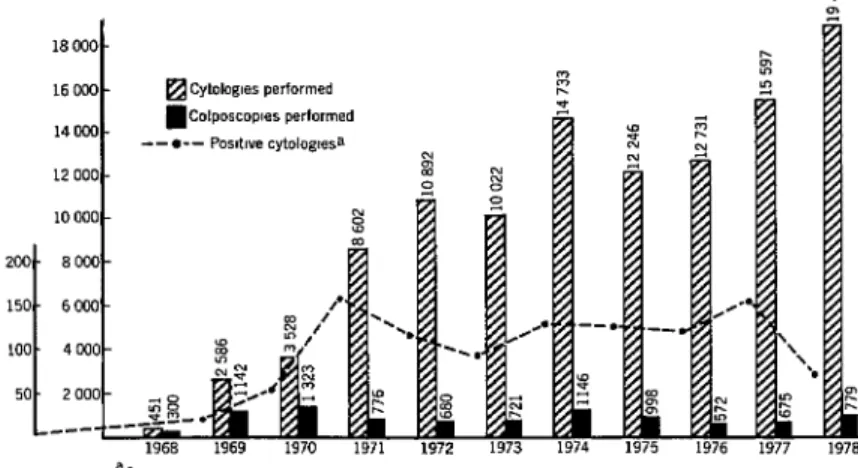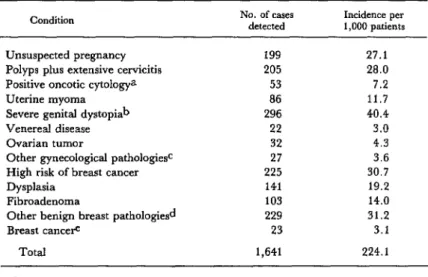PREVENTIVE
OBSTETRICS
AND GYNECOLOGY
PROGRAM:
PILOT
PLAN FOR INTEGRATED
MEDICAL
CARE1
J. A. Pinotti,g
H. B. Brenelli,s J. D. Moragues,”
L. L. Pastene,4
R.&B.
Ramos,5 R. Barini,s
C. da Silva Alves,” M. T. Stano,G
and L. E. Bigattis
A special screening program established at the universily hospital of Campinas (Sio Paula, Brazil) delected major gynecological 07 breast pathologies in nearly a quarter of thefemale outpatients coming to the hospitalfor other kina!s of com- plaints. These findings clearly demonstrate that primary care needs to be pro-
videdfor such patients, and that in the absence of an gective national or local primary care system individual hospitals should be aware of the need to conduct primary care screening before providing specialized consultation.
Introduction
Eleven years ago the State University of Campinas of the State of SIo Paulo, Brazil, acting through its Department of Obstetrics and Gynecology, organized vertical programs designed to introduce various types of health care at the community level. Some of these programs were very successful, and some (like the cervical cancer control program) have con- tinued to do highly productive work. At present over 60 per cent of the at-risk female population of the area served is covered by the cervical cancer control program, and the pro- gram’s quantitative and qualitative results (see Figure 1) have improved steadily. Another example, a breast cancer control pro- gram utilizing paramedical personnel, has proved a viable model for similar programs elsewhere in Latin America. This program’s
1 Also appearing in Portuguese in the Bolt-tin de Ia
Ojcina Ponameri~ano 90(2):144-151, 1981.
2Professor of Obstetrics and Gynecology, Department of Obstetrics and Gynecology, School of Medical Sciences, State University of Campinas (UNICAMP).
SAssistant, Department of Obstetrics and Gynecology, School of Medical Sciences, UNICAMP.
*Nurse, Department of Obstetrics and Gynecology, School of Medical Sciences, UNICAMP.
5Social worker, Department of Obstetrics and Gyne- cology, School of Medical Sciences, UNICAMP.
6Doctoral candidate, School of Medical Sciences, UNICAMP.
pilot project, which has included both in- hospital and community activities, has de- tected breast cancer in 0.45 per cent of the women screened who were over 35 years of age.
Other vertical community-oriented pro- grams organized by the Department of Obstetrics and Gynecology include a program for prevention of high-risk pregnancies, a family planning program, a program to pro- mote breast-feeding, and a puerperal care program. It had been our opinion for several years that all these programs should be tied together-reorganized horizontally-so as to offer a simple, practical, and inexpensive way of detecting and preventing pathological con- ditions in a comprehensive and integrated fashion to the women of the lower socioeco- nomic and cultural strata served. Primary care had not been available to the patient population seen at the university’s clinical hospital, because neither the national health system nor (especially) the state health system of Slo Paul0 had become organized to provide it. Consequently, patients with various suspected pathologies but without any prior screening were coming to the clinical hospital merely on the basis of needs they had felt as a result of their symptoms.
Because of this problem, which reflected lack of organization within the health system,
Pinotti et al. l PREVENTIVE OBSTETRICS AND GYNECOLOGY PROGRAM 105
Figure 1. History of the Campinas cervical cancer control program, 1968-1978.
the clinical hospital was not operating as a referral hospital, thereby wasting scarce re-
sources. Furthermore, a situation was created
in which the patients were screened and treated symptomatically, without having been routinely examined previously by the primary care network. As a result, they were often fail- ing to receive the type of care most indicated for whatever actual problems they might have.
In view of the foregoing, when one of the authors became Director of the School of Medical Sciences four years ago, a new screen- ing system was established. All women visiting the university hospital for any non- gynecological complaint-women who would not normally have attended the gynecology outpatient clinic-were routed to an experi- mental outpatient service. This service, staffed by paramedical personnel and medical students working under physicians’ supervi- sion, performed simple gynecological and breast examinations. The aims of this new program were as follows:
l to check for inapparent obstetrical and gyne-
cological pathologies in women whose overt symp- toms would not require this kind of examination;
l to try to determine these patients’ needs in
terms of primary care-care completely different from what they were receiving at the referral hospital level;
l to study the viability of a triage methodology
completely distinct from the university hospital’s, which could be applied until such time as a primary care system linked to the clinical hospital could be organized.
Materials and Methods
All female patients arriving at the registra- tion desk of the clinical hospital, which is located in the Santa Casa de Misericbrdia de Cam-
pinas building, were directed to the Experi-
mental Preventive Obstetrics and Gynecology Outpatient Unit before consultation. As indi- cated in Figure 2, advantage was taken of the time interval between patient registration at the hospital (which is done in the morning) and the specialized consultations, which are done in the afternoon. The age distribution of the patients involved is shown in Table 1, and the various steps of the outpatient screening process are shown in Figure 3.
Figure 2. Patient flow chart for the obstetrics Table 1. Age distribution of the women screened and gynecology program. by the Campinas program as of mid-1977.
?
s ~18
Years wth no gynecologm +or breast complamts
Age PUP patients No. of % of total
c 20 years 754 10.3 20-29 years 2,112 20.0 30-39 years 1,579 21.6 2 40 years 2,875 39.3
Total 7,320 100.0
GENERAL HOSPITAL REGISTRATION
7:oo 9,00 a m.
T
>~j9.00. 11:OO a.rn
Figure 3. Steps in the outpatient screening process at the Campinas program’s obstetrics
and gynecology screening unit.
1. REGISTRATION (attendants)
2. ORIENTATION
(provided by social worker to groups of patients)
3. SCREENING EXAMINATION (by supervised nurses or medical students)
4. APPLICATION OF RISK CRITERIA (by supervised nurses
or medical students)
BRIEF HISTORY
COLPOSCOPY, PAP SMEAR
BIMANUAL PELVIC EXAMINATION
BREAST PALPATION
HIGH RISK OF BREAST CANCER
HIGH-RISK PREGNANCY
Pinotti et al.
lPREVENTIVE
OBSTETRICS AND GYNECOLOGY
PROGRAM
107
The patient waiting
room, where orientation
sessions were conducted.
These marginal
and cramped quarters did not interfere
with program development.
tion should be repeated-preferably
annually,
but at least once every two years. The screen-
ing examination,
performed
by an especially
trained
medical student,
nurse, or midwife,
includes brief review of the patient’s
genito-
urinary
history;
examination
with
a
speculum; collection of material for a Papani-
colaou smear (and of discharge specimens if
leukorrhea
is present); 7 bimanual
pelvic
examination;
and breast palpation.
The form
completed during the course of the examina-
tion is shown in Figure 4.
The next step is to consider risk factors,
7Pap
smears are collected, fixed, and sent to the pathologist. When leukorrhea is present a discharge specimen is collected and examined fresh. If the results are positive, treatment is given immediately.principally
those relating to breast cancer and
high-risk
pregnancy.
Finally,
after examina-
tion the patient receives guidance about treat-
ment of certain simple pathologies,
is referred
if appropriate
to specialized services, and is
asked to return if necessary. Records are kept
,of all pathologies found for purposes of future
investigation.
The physical layout of the facilities used has
been very rudimentary.
There are two rooms,
both 2 by 3 meters in size, and a hall about 2
by 5 meters. The hall has been used as the
waiting room (see photo) for all patients par-
ticipating
in this program-as
well as those
receiving care from other outpatient
programs
for such conditions
as high-risk
pregnancy,
Card No. Name Street District Race
Name of husband
(Pat. Reg. No.)
Marital Status
Cytology No. MG= No.-
Age Number City
Physician Date
Place of employment
Mammary hlstory
Relative with mammary cancer- 1st menstruation -Years Menopause Years 1st pregnancy Years Use of hormones q q
Previous history q f&l
Ga-Pa__Aa c=-
Cervical Start of sexual
history activity Years Discharge IYBI Gynecological surgery [41 i@ Cauterization l IY [El
Breast exam. lNRlOEl
MGa
(NRI
bl q
TPa INRIElEi Cervical exam. lNRlDitm Colp. lNRl lzl H Cytology INAIEIEI Ovarian exam. IEIOEI Bimanual exam. @q q
Endometrial lavage m @Iq
Diag. breasts j%JiTJ rfiziq Perform. ~ Diag. cervix p-ilpj riitxkq Perform. ~ Diag. ovaries m/q rciiFzq Perform. ~ Dlag. endometrlum flFj j?iiiErj Perform. - Observations
Date Cytology No. MG No.
Breast exam. lNRlOEl MG m
q q
TP lNRlmEl Cervical exam. am m lq Colp. lNRl i4 LFi cytoloclY IEIOEI Ovarian exam. INRIEIIEI Bimanual exam. IiElmm Endometrial lavage lNRlElElDiag. breasts Elm -lb Perform. ~ Diag. cervix 14 lq l-GFzqb Perform. ~ Diag. ovaries pqlq psiqb Perform. ~ Diag. endometrium pJm pzEqb Perform. ~
aMG = mammography; G = No. of pregnancies, P = No. of deliveries; A = No. of abortions; C = No. of cesarean sections; and TP = plate thermography.
obstetrics and gynecology screening unit.
Date Cytology No. MG No.
Breast exam. lNRlElEl MG m
q
k?l TP lNRlm.lEl Cervical exam. lNRlElm Colp. lNRlq
kl Cytology INRImm Ovarian exam. lNRlalzl Bimanual exam. k$q q
Endometrial lavage IEIOEIDiag. breasts pJpJ lT5iiq Perform. ~ Diag. cervix Elm IcnRcc] Perform. __ Diag. ovaries IIll m Perform. ~ Diag. endometrium l-iqlq l-Gziq Perform. Observations
Date Cytology No. MG No.
Breast exam. IEllilEl MGmmk/ TP lNRlElEl Cervical exam. @IElm Colp. lNRl iz4 !zl wologY INRIElm Ovarian exam. lNRlOm Bimanual exam. a H
q
Endometrial lavage mq q
Diag. breasts pJm l7ziz-l Perform. ~ Diag. cervix mEI IGARCC( Perform. ~ Diag. ovaries l-KJm /-Gq Perform. ~ Diag. endometrium
q m
JGARCE]
Perform. ~Date Cytology No. MG No.
Breast exam. lNRlmm MG kid iid @ TP mImEI Cervical exam. IEitElm Colp. lNRl I3 H WOlWY lEtmEl Ovarian exam. INRItElEl Bimanual exam. m
q q
Endometrial lavage mq q
Results
In mid-1977, after 7,320 cases had been examined, an analysis was made of the major pathologies detected and their incidence per
1,000 patients screened. The results of that analysis are shown in Table 2.
Conditions classified as “severe genital dystopias” were rectocele, cystocele, perineal rupture (grade 3), and prolapse of the uterus (grades 2 and 3). Conditions classified as
“other gynecological pathologies” were pyosalpingitis, leukoplakia vulvae, secondary amenorrhea, bartholinitis, endometritis, giant cervical cyst, metrorrhea, severe genital mal- formations, gartnerian cyst, and vaginal stenosis. Conditions classified as “other benign breast pathologies” were papillary discharge, cutaneous lesions, mammary cyst,
abscess, ectopic breast, mastalgia, mammary hypertrophy, and supernumerary mammae. The incidence of breast cancer detected among women over 30 years of age was 5.4 cases per 1,000 patients.
As Table 2 shows, among the conditions detected by the screening were unsuspected pregnancies (27 per l,OOO), severe genital dystopias (40 per 1 ,OOO), and positive oncotic cytology (7.2 per 1,000). The overall preva- lence of major gynecological pathologies among the women who came to the outpatient clinic for nongynecological problems was 224 per 1,000.
These findings clearly demonstrate the urgent need to provide primary care for this class of patients- a need, we would venture to say, that is far more urgent than such patients’ need for the type of care available at the level
Table 2. Gynecological and breast pathologies and unsuspected pregnancies found in 7,320 women examined at the obstetrics and gynecology outpatient unit
through mid-1977. Certain “minor” pathologies, such as trichomoniasis (found in 9.4 per cent of the patients), were not considered.
Condition No. of cases detected Incidence per 1,000 patients
Unsuspected pregnancy 199 27.1
Polyps plus extensive cervicitis 205 28.0 Positive oncotic
cyt0l0gya
53 7.2Uterine myoma 86 11.7
Severe genital dystopiab 296 40.4
Venereal disease 22 3.0
Ovarian tumor 32 4.3
Other gynecological pathologiesc 27 3.6 High risk of breast cancer 225 30.7
Dysplasia 141 19.2
Fibroadenoma 103 14.0
Other benign breast patho1ogies.d 229 31.2
Breast cancere 23 3.1
Total 1,641 224.1
aCategory III, IV, or V.
bRectoceIe, cystocele, perineal rupture (grade 3) and prolapse of the uterus (grades 2 and 3).
cPyosalpingitis, leukoplakia vulvae, secondary amenorrhea, bartholinitis, endome- tritis, giant cervical cyst, metrorrhea, severe genital malformations, gartnerian cyst, vaginal stenosis.
dpaptilary discharge, cutaneous lesions, mammary cyst, abscess, ectopic breast, mastalgia, mammary hypertrophy, and supernumerary breast.
Pinotti et al. l PRIWENTKVE OBSTETRICS AND GYNECOLOGY PROGRAM 111
of the university hospital. In many cases, various minor pathologies of slight importance for the patients’ general health brought them to the hospital. These included otitis, laryngi- tis, visual or hearing problems, influenza, colds, and so forth. Most of these problems would have been handled very capably by our excellent specialists. In reality, however, the attention received would have been inade- quate, since many patients were suffering from serious gynecological pathologies- including tumors in some cases-that would have been overlooked. This illustrates the point that primary care is not just relevant and important, but it is often more important than the care available at the university hospital level.
Another noteworthy point is that patients from the socioeconomic levels involved here- and probably all socioeconomic levels-are not well-prepared to evaluate the true order of importance of their illnesses, and so they should be helped to do so before receiving any other type of attention. Such help should be offered at the primary care level. However, since primary care services are not appro- priately organized in our country, it is impor- tant that the clinical or other hospitals receiv- ing patients be aware of the imperative need to provide this kind of attention before caring for the illness recognized by the patient.
It was also found in the course of our pro- gram that a large number of patients came to the hospital for very trivial problems that could have been resolved without doing all the necessary paperwork and going through the process of being treated at a referral hospital. We also found that very simple consultations, without recourse to specialists, were able to resolve a large share of these patients’ prob- lems at the level of the outpatient unit, dis- pensing with bureaucracy altogether.
It should be stressed, however, that simpli- fied medicine does not imply low-quality medicine; rather, it implies delivering the care a particular patient needs in a simple and effi- cient fashion. In this vein, medical students and young physicians should be made aware
that providing precisely the care needed in a simple and efficient manner, without sacrific- ing quality, is far preferable to providing sophisticated care for the patient’s expressed needs-employing complex and expensive equipment and an academic approach without considering the patient’s diverse organic aspects as a whole.
It is true that the simplified medical atten- tion provided in some health care areas by paramedical personnel is viewed with certain reservations. This may be due to inadequate understanding of the problem at hand. If so, it is our belief that the results of the study reported here will help to diminish such reser- vations by showing that when a program and its objectives are well-defined, delegation of functions does not reduce the quality of care.
Conclusions
Our data indicate that women seeking medical care at referral hospitals like ours should first be helped to evaluate their health problems according to those problems’ true order of importance-since the problem recognized by the patient is often not the most pressing one involved. At the same time, the high incidence of gynecological pathologies detected by our program signals a need- under the health conditions prevailing in Brazil-for all women seeking care to receive a simple gynecological examination of the kind performed by our unit.
Our findings provide additional evidence of the need to organize a primary care system in our region and possibly throughout Brazil. They also demonstrate that the health system needs to be reorganized in such a way that adequate facilities are made available for referrals and counter-referrals within the system.
dure. In addition, it may be assumed that given to developing a similar program to serve comparable health problems also exist among them.
adult males, and so consideration should be
SUMMARY
At one time, women coming to the hospital of the School of Medical Sciences of the University of Campinas (in the Brazilian state of SZo Paulo) were referred to specialized consultations on the basis of the needs they themselves expressed. This proce- dure, which meant that minor ailments were being treated while major ailments were often overlooked, made the hospital operate as a primary care center and misdirected the attentions of its scarce and expensive specialized resources.
To help cope with this problem, the School of Medical Sciences established a special gynecologi- cal screening unit for all female outpatients coming to the hospital with nongynecological complaints. The unit, staffed by physician-supervised paramed- ical personnel and medical students, performed
simple gynecological and breast examinations in an effort to detect pathological conditions in need of treatment before the patients were referred to
specialized consultation. These examinations detected major pathologies in 22.4 per cent of the first 7,320 women screened.
These findings clearly demonstrate an urgent need to provide primary care for the type of patient served by the screening unit. They also indicate that when primary care services are not appropri- ately organized in the country or area served, then clinical or other hospitals receiving patients should be aware of the imperative necessity of providing this kind of care before tending to the illness recog- nized by the patient.
(1) Pinotti, J. A. Exper%ncia crftica do pro- (3) Taylor, H. C., and A. G. Rosenfield. A grama de contr6le de clncer ctrvico uterino de family planning program based on maternal and Campinas-Brasil. Jomal Bradeiro de Ginecologia 82 child health services. Am J Obstet Gynecof
(4):461-471, 1976. 120(6): 733-745, 1974.
(2) Pinotti, J. A., and S.R.F. Borges. Segui- (4) Rosenfield, A. G., and C. Limcharoen. mento efetivo dos cases detectados de carcinoma do Auxiliary midwife prescription of oral contracep- co10 uterino. Boletin de la Oficina Sanitaria Panurnen’ca- tives. Am J Obslet Gynecol 115(7):942-949, 1972.


